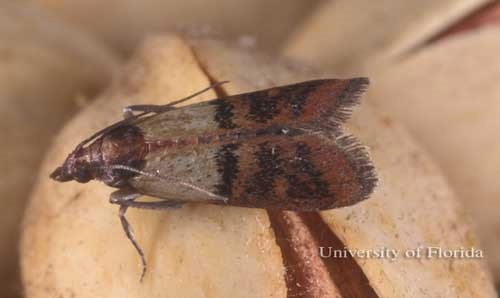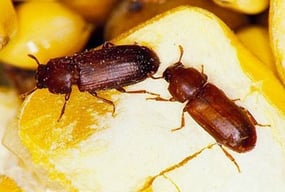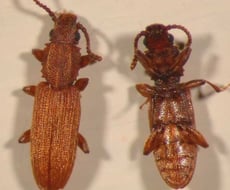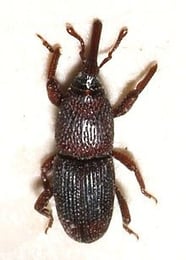Have you created a new year’s resolution that includes keeping a more organized and clean home but as you were cleaning out your kitchen cabinets you came across bugs? No need to panic! More than likely the bugs you came across are just pantry pests. These bugs may cause some alarm to you as they are usually found within cabinets or pantry food items but don’t worry, they won’t cause any harm to you, your family or your home.
Where are they lurking?
As with many pests, pantry pests tend to harbor near their food source and for pantry pests that includes the food in your cupboards. There are a few different types of pantry pests that might be lurking in your cabinets, but the most common ones are moths and small beetles, including weevils.
What is an Indian Meal Moth?

Indian Meal Moth. Photo Credit: University of Florida
According to Penn State University’s Department of Entomology, “The Indian meal moth, Plodia interpunctella (Hubner) is one of the most commonly reported pests of stored grains in the United States.” Since the Indian meal moth larvae feed on grains, grain products, dried fruits, nuts, cereals, and a variety of processed food products, they can be a troublesome pest for pantries and storage facilities.
The markings of the Indian Meal Moth makes it easier to distinguish from other pantry pests. According to Penn State University, the forewings of the moth are “reddish brown with a copper luster on the outer two-thirds, but whitish gray on the inner or body ends. The hind wings lack distinctive markings and are more or less uniformly gray.”
What Beetles are Common Pantry Pests?


Flour Beetles and Saw-toothed Grain Beetle. Photo Credit: Michigan State University
There are a variety of beetles that can make their way into your home and pantry but the most common pantry beetles are saw-tooth grained beetles and flour beetles and grain weevils. Saw-tooth grain beetles prefer flour, pasta, and cereal whereas the flour beetles like to eat flour, cereals and meal.
What is a Weevil?

Wheat Weevil
Photo Credit: Wikipedia
Weevils are small, reddish-brown beetles with an elongated snout and are often found in kitchen cupboards and pantries. Unlike many other types of grain pests, they do not feed on processed food products such as flour, corn meal, pasta, etc. Instead, weevils attack whole grains, beans or seeds. For example, wheat weevils, also known as the grain or granary weevil, prefer whole wheat, oats, rye, barley, rice and corn, as well as a variety of whole beans. Weevils can sometimes hard to detect within a pantry.
How Did these Pests Get Into My Pantry?
Even though you may have a clean home, that doesn’t mean that your pantry is safe from pests. Of course, some of these pests can make their way into your home from the outdoors, but the majority of them can come into the home already inside of the food products.
These pests can be very problematic for food production facilities, and the infestations can originate there or even other locations, including delivery trucks, processing warehouses or grocery stores. The longer a food supply is sitting in one location, the greater the chances for an infestation to occur.
What Can I do to Get Rid of Pantry Pests?
As with any bug infestation, the key to eliminating the problem is finding the source of the problem. Once you find where the infestation originated, then you can begin the control steps to eradicate the pests.
First off, determine if you have an infestation. If you have seen a beetle or two in locations where you don’t typically store food that may not necessarily be an infestation, however, if you notice a few in locations near your cabinets where food is stored, it may be possible that you have an infestation.
Next, if you determine that you have an infestation, you need to locate it and remove the infested food. Pantry pests can feed on cereals, various grains, crackers, spices, macaroni, dried fruit, chocolate, candy, nuts, dried peas or beans as well as pet food, like bird seed or dog food.
Once you can locate the infested food, the number of bugs should dramatically decrease. You may notice the adult beetles searching for another food source so be sure that all other food is stored in air-tight plastic or glass containers. If you have other food sources in boxes nearby, check to ensure that they haven’t been infested as well.
Pesticides are NOT recommended when dealing with pantry pests. Simply clean up the cabinets by vacuuming and washing all of the shelves, countertops and floors in your kitchen.
Since pantry pests can sometimes be difficult to get rid of, it is recommended that you contact your local pest control company to eliminate the pests.
Tips for Keeping the Pests Out of Your Pantry
National Pest Management Association (NPMA) has created a few helpful tips on how to keep your pantry free from pests.
- Properly store your food in sealed plastic or glass containers with secure lids.
- When food shopping, do not purchase boxes that already look damaged and inspect all bags/boxes prior to purchasing to ensure that they are securely sealed.
- Check the expiration dates on the food in your cabinets and periodically sort through older items in your pantry. Dispose of any food that has been stored for a long period of time.
- Add bay leaves to your canisters and packages in your pantry to keep pantry pests out. The herb’s smell is typically pungent to most pantry pests.
- Regularly clean up all crumbs and spills in your kitchen. Dispose of any trash laying around in a sealed receptacle.
How to Reduce the Likelihood of Bringing Pantry Pests into Your Home
In order to reduce the chance of introducing grain pests into your home follow these guidelines as provided by Cooper Pest Solutions.
- Beware if you see moths or beetles on shelves or in the air when you are in store aisles where items such as rice, grains, flour, cereals, crackers, pet foods and other stored products are present.
- Be careful when buying bulk food items such as grains, spices, pet foods, birdseed etc. These items tend to be vulnerable to grain pest infestations.
- Be careful when purchasing pet foods particularly dog food and dog biscuits. These materials are very commonly infested.
- Be careful when purchasing birdseed and bird suet. These products almost always are infested and can lead to grain pest infestations in your home.
- Be careful when buying specialty items from the store such as international foods, holiday specialty items i.e. matzah meal, corn meal etc. These types of products often sit on store shelves longer than staple food products and are highly susceptible to grain pest infestation.
If you’re still having problems getting rid of the pantry pests, give Cooper Pest Solutions a call at 1-800-949-2667 or fill out our free estimate form and one of our highly skilled representatives will provide you with a free, no-obligation pest inspection at your home.











